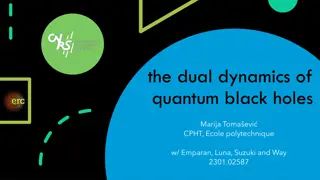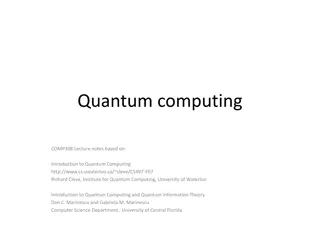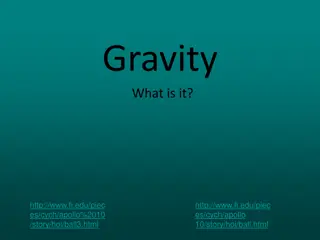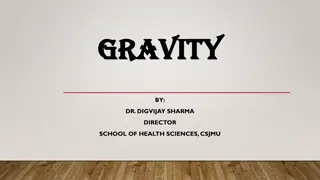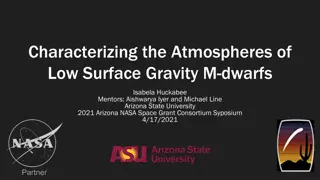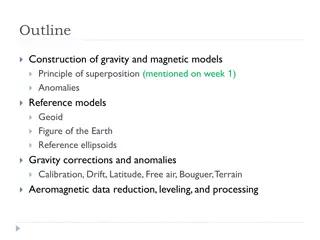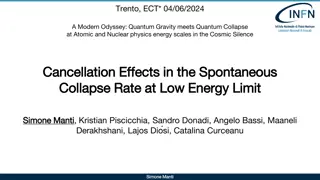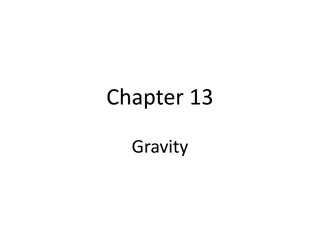Exploring Quantum Field Theory for Gravity and Dark Energy
Delve into the fascinating realms of quantum field theory as applied to gravity and dark energy, unraveling the mysteries of the universe through concepts like vacuum energy, cosmological constants, and dark energy models. Discover the interconnected web of theories concerning the early universe, inflation models, and the intriguing nature of vacuum energy influenced by fundamental fields and quantum fluctuations.
Download Presentation

Please find below an Image/Link to download the presentation.
The content on the website is provided AS IS for your information and personal use only. It may not be sold, licensed, or shared on other websites without obtaining consent from the author. Download presentation by click this link. If you encounter any issues during the download, it is possible that the publisher has removed the file from their server.
E N D
Presentation Transcript
Quantum Field Theory for Gravity and Dark Energy Sang Pyo Kim Kunsan Nat l Univ. & APCTP CosPA2009, U. Melbourne, 2009
Outline Motivation Vacuum Energy and Cosmological Constant QFT Method for Gravity Conformal Anomaly Dark Energy Conclusion
Friedmann-Lemaitre- Robertson-Walker Universe The large scale structure of the universe is homogeneous and isotropic, described by the metric + 1 Kr 2 dr = + d + d 2 2 2 2 2 2 2 ( ) ( sin ) ds dt a t r 2 The theory for gravity is Einstein gravity GT g G 8 = + ( ) a t Friedmann equations in terms of the redshift + z = obs t 1 ( ) a em 2 a = = + + + + + + 2 2 0 4 3 2 ( ) [ 1 ( 0 ) 1 ( 0 ) 1 ( 0 ) ] H z H z z z 0 R M K a a 1 = + + + 2 0 4 3 [ 1 ( 0 ) 1 ( 0 ) ] H z z 0 R M 2 a
Hubble Parameter & Dark Energy Radiation 2 ( z H + 2 0 4 ) 1 ( ) H z 0 R Matter 2 H + 2 0 3 ( ) 1 ( ) z H z 0 M Curvature ( z H + 2 2 0 2 ) 1 ( ) H z 0 K Cosmological constant 2 ) ( H z H 2 0 0 WMAP-5 year data
Dark Energy Models [Copeland, Sami, Tsujikawa, hep-th/0603057] Cosmological constant w/wo quantum gravity Scalar field models: what is the origin of these fields? Quintessence K-essence Tachyon field Phantom (ghost) field Dilatonic dark energy Chaplygin gas Modified gravity: how to reconcile the QG scale with ? f(R) gravities DGP model
Early Universe & Inflation Models 2 m = + + 2 2 4 ( ) V R Chaotic Inflation Model 2 2 ! 4
Vacuum Energy and Vacuum energy of fundamental fields due to quantum fluctuations (uncertainty principle): massive scalar: d 2 4 cut 3 1 k = + cut 2 2 m k 3 2 vac 2 ( ) 16 0 = 71 4 Planck scale cut-off: 10 ( GeV ) vac = = 47 4 present value: 10 ( GeV ) 8 G order of 120 difference for the Planck scale cut-off and order 40 for the QCD scale cut-off Casimir force from vacuum fluctuations is physical.
Vacuum Energy and The uncertainty principle prevents the vacuum energy from vanishing, unless some mechanism cancels it. Cosmological constant problem how to resolve the huge gap? renormalization, for instance, spinor QED ) ( 2 2 eff s 2 2 / m s qE qE e = + sp [cot( ) / 1 vacuum ] 3 / charge L ds s s s 8 0 energy supersymmetry, for instance, scalar and spinor QED with the same spin multiplicity ) ( 2 2 eff eff s 2 2 / m s qE qE e ) s + = / 1 sp sc cot( ) sin( L L ds s 8 0
Vacuum Energy in an Expanding Universe What is the effect on the vacuum energy of the expansion of the universe? Unless it decays into light particles, it will fluctuate around the minimum forever! A systematic treatment next
QFT for Gravity Charged scalar field in curved spacetime = = + = 2 ( ) , 0 ( ) , ( ) H x H x D D m D iqA x Effective action in the Schwinger-DeWitt proper time integral = = det( iH 1 ) ( 2 e is d g x d 1 i iH = [ ] iW iS [ ] , Tr ln e d e W 2 2 2 2 / 2 ) i = d isH | | ' W d x g d is x e x ( ) is 0 2 im s 1 = d ( ) ( , ; ' x ) F x is / 2 d 2 ( )( 4 ) is s 0 One-loop corrections to gravity 1 , 2 1 = = 1 1 1 ; + + 2 f R f R R R R R R ; 30 12 180 180
Nonperturbative QFT The in- and out-state formalism [Schwinger (51), Nikishov (70), DeWitt (75), Ambjorn et al (83)] 3 = = e e i dtd xL iW 0, out | 0, in eff The Bogoliubov transformation = in k, in k, out k, b b + k, + k + = * k, a a b U a U in in k k, in + k, + k = + = * k, a U b U k, out k, in k, in in in k k, in
Nonperturbative QFT The effective action for boson/fermion [SPK, Lee, Yoon, PRD 78 (08)] k = = * k ln 0, out | 0, in ln W i i Sum of all one-loops with even number of external gravitons
QED vs QG QED Schwinger Mechanism QCD Unruh Effect Pair Production Black holes Hawking Radiation De Sitter/ Expanding universe
QG Analog of QED Naively assume the correspondence between two accelerations (Hawking-Unruh effect) R qE = dS H 12 m The vacuum structure of one-loop effective action for dS may take the form [Das,Dunne(06)] ) ( ) ( = n + 2 n ( ) 2 n R mH + 2 3 4 2 n dS m L R eff dS + + + 2 2 8 2 ( 4 )( 2 )( ) 2 12 n n n 0 2 ( ) mH 2 / / 12 m R Im ( ) L R e dS eff dS 2 32
Effective Action for de Sitter de Sitter space with the metric ( cosh + = dt ds + 2 2 2 2 2 3 2 )( sin ) Ht d d Bogoliubov coefficients [Mottola, PRD35 (85)] 1 ( i k ) ( ) i i + = , k Z k / 3 + i i / 1 i ( 2 ) ( 2 ) k i 1 ( ) 1 2 k ) ( k ) ( 9 m = = = , k / 3 + / 1 2 ( ) 2 ( ) 2 sinh( ) 4 k H
Effective Action for dS Using the gamma function and doing the contour integral, we obtain the effective action and the imaginary part: + 2 s ( ) 2 cos( ) 2 / cos( s ) 1 mH e s k s = k = + ( ) 2 ( 0 ) 1 L H k P ds eff 64 sin( ) 2 / s 0 + 2 ( 2 ) 1 n 1 e = n = = 2 Im ( ) 2 ln(tanh ( )) L H eff + 2 1 2 n 0
Effective Action for de Sitter Renormalization of constants = ( cosmologic ) ( gravitatio ) 6 m + + div eff 4 2 ( ) L R m m R dS dS nal R dS 1/R - term al constant constant The effective action after renormalization s 2 ( ) 2 cos( ) 2 / 1 / 1 s 6 13 mH e s = ( ) L H ds eff 4 4 2 64 sin ( ) 2 / ( ) 2 / ( ) 2 / 120 s s s 0
Effective Action for de Sitter The vacuum structure of de Sitter in the weak curvature limit (H<<m) + 1 n R = n = 2 ( ) dS L R m R C eff dS dS n 2 m 0 The general relation holds between vacuum persistence and mean number of produced pairs k 2 = = + 2 Im ( ) L H 2 2 0, out | 0, in exp ( ) 1 ln(tanh ( )) e k eff = 0
QFT for Gravity and The cosmological constant from the effective action from QFT 4 off cut = m the cut-off from particle physics yields too large to explain the dark energy. QFT needs the renormalization of bare coupling constants such gravitation constant, cosmological constant and coupling constants for higher curvature terms. A caveat: the nonperturvative effect suggests a term 1/R in the action.
Conformal Anomaly An anomaly in QFT is a classical symmetry which is broken at the quantum level, such as the energy momentum tensor, which is conserved due to the Bianchi identity even in curved spacetimes. The conformal anomaly is the anomaly under the conformal transformation: E b F b T 2 1 3 * * R R R R E = = 2 = g e g ) + 2 = + 2 2 ( R b R 3 + 2 4 R R R 1 = = + 2 2 F C C R R R R R 3
FLRW Universe and Conformal Anomaly The FLRW universe with the metric 2 2 2 2 ) ( x d t a dt ds + = has the conformal Killing vector: Hg g L 2 = t ij ij The FLRW metric in the conformal time )( ( d a ds = + 2 2 2 2 ) d x The scale factor of the universe is just a conformal one, which leads to conformal anomaly.
FLRW Universe and Conformal Anomaly At the classical level, the QCD Lagrangian is conformally invariant for m=0: 1 i G G L a QCD + = + a ) a a ( gT A m 4 At the quantum level, the scale factor leads to the conformal anomaly [Crewther, PRL 28 (72)] ) ( G G T a = g + + a 1 ( ( )) m m ren 2 ren ren The FLRW universe leads to the QCD conformal anomaly [Schultzhold, PRL 89 (02)] ) ( = = H O T QCD = 3 29 3 10 / g cm 0 ren
Conformal Anomaly The conformal anomaly from the nonperturbative renormalized effective action is 6 4 0 eff ) ( m 3 dS R H = + + = + + 2 dS L H C H C C R C 2 0 2 2 2 m The first term is too small to explain the dark energy at the present epoch; but it may be important in the very early stage of the universe even up to the Planckian regime. The trace anomaly may drive the inflation [Hawking, Hertog, Reall PRD (01)].
Canonical QFT for Gravity A free field has the Hamiltonian in Fourier-mode decomposition in FLRW universe 3 2 k 3 2 1 a a d k k = + = + 2 k 2 k 2 k 2 ( ) , H t m 3 3 2 2 ( ) 2 2 a The quantum theory is the Schrodinger equation and the vacuum energy density is [SPK et al, PRD 56(97); 62(00); 64(01); 65(02); 68(03); JHEP0412(04)] ) 2 ( 2 3 3 a d k = = + * 2 * ( ) H t k k k k k 3
Canonical QFT for Gravity Assume an adiabatic expansion of the universe, which leads to / ) ( e t k = i dt 3 2 a k k The vacuum energy density given by 1 3 3 2 9 9 d k H H = + 3 cut [ ] ( ) ( ) H off k 2 2 2 ( ) 8 32 m B k renormaliz ation of bare B is the same as by Schultzhold if but the result is from nonequilibrium quantum field theory in FLRW universe. Equation of state: = H 2 H = m B 3 2 1 9 d k ) H p 8 3 2 ( k
Conformal Anomaly, Black Holes and de Sitter Space Hawking temperature Black Holes Thermodynamics = Einstein Equation Jacobson, PRL (95) Bekenstein-Hawking entropy at event horizon Conformal Anomaly ?? Hartle-Hawking temperature First Law of Thermodynamics = Friedmann Equation Cai, SPK, JHEP(05) Cosmological entropy at apparent horizon
Summary The effective QFT for gravity may provide an understanding of the dark energy. The QCD conformal anomaly in the FLRW universe may give the correct order of magnitude for the dark energy and explain the coincidence problem (how dark matter and dark energy has the same order of magnitude). The conformal anomaly may lead to a logarithmic correction to black hole entropy and higher power of Hubble constants.




